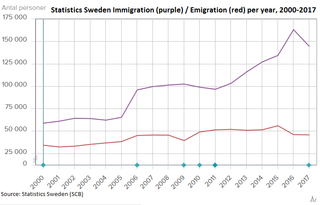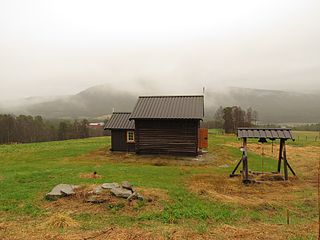| Total population | |
|---|---|
| 27,855 (2020 Official Norway estimate) [1] 0.52% of the Norwegian population | |
| Regions with significant populations | |
| Oslo | |
| Languages | |
| Tigrinya · Tigre · Kunama · Nara · Afar, · Beja · Saho · Bilen · Arabic · English · Norwegian | |
| Religion | |
| Eritrean Orthodox, Islam |
Eritreans in Norway are citizens and residents of Norway who are of Eritrean descent. Most have a background as asylum seekers that have fled Isaias Afwerkis regime.
According to Statistics Norway, in 2017, there are a total 19,957 persons of Eritrean origin living in Norway. Of those, 3,661 individuals were born in Norway to immigrant parents. [1] In 2020 the number had risen to 27,855 people, making Eritreans the second biggest migration group from Africa after Somalis. [2]
According to Statistics Norway, as of 2014, around 59% of Eritrea-born immigrants have a persistently low income. This was a higher proportion than the native population and many other immigrant groups, largely because most Eritrean individuals arrived as asylum immigrants, who tend to have lower incomes. Persons born in Norway to Eritrean immigrants have a significantly smaller low income percentage of approximately 28%. [3]
According to Statistics Norway, in the 2010-2013 period, the proportion of Eritrea-born perpetrators of criminal offences aged 15 and older in Norway was 79.94 per 1000 residents. When corrected for variables such as age and gender as well as employment, the total decreased to 67.09 after age and gender adjustment and to 52.75 after employment adjustment. This is higher compared to the averages of 44.9 among native Norwegians. [4] As of 2015, a total of 547 Eritrea citizens residing in Norway incurred sanctions. The principal breaches were traffic offences (330 individuals), followed by other offences for profit (60 individuals), public order and integrity violations (51 individuals), violence and maltreatment (39 individuals), drug and alcohol offences (35 individuals), property theft (22 individuals), sexual offences (8 individuals), criminal damage (2 individuals), and other offences (0 individuals). [5]
According to Statistics Norway, as of 2016, among a total 17,022 Eritrea-born immigrants aged 16 and older, 12,302 individuals had attained a below upper secondary education level, 2,429 had attained an upper secondary education level, 193 had attained a tertiary vocational education level, 1,392 had attained a higher education level of up to four years in duration, 299 had attained a higher education level of more than four years in duration, and 407 had no education. [6]
According to Statistics Norway, as of 2016, Eritrea-born immigrants aged 15-74 in Norway have an employment rate of approximately 37.9%. [7] As of 2017 [update] , their unemployment rate was also about 4.5%. [8]

The Somali diaspora or Qurbajoogta refers to Somalis who were born in Greater Somalia and reside in areas of the world that they were not born in. The civil war in Somalia greatly increased the size of the Somali diaspora, as many Somalis moved from Greater Somalia primarily to Europe, North America, Southern Africa and Australia. There are also small Somali populations in other pockets of Europe and Asia. The UN estimates that in 2015, approximately 2 million people from Somalia were living outside of the country's borders.
Norwegian Vietnamese or Vietnamese Norwegian refers to citizens or naturalized residents of Norway of partially and full Vietnamese descent.
Pakistani Norwegians are Norwegians of Pakistani descent, around half of the Pakistani population in Norway are Punjabis and 65.23% of Pakistanis in Norway live in the capital Oslo. First-generation Pakistani Norwegians, who migrate from Pakistan, are distinguished from the mainstream in several demographic aspects, while second-generation Pakistani Norwegians, who are born in Norway, are well established in Norway and have gone on to become professionals and politicians.
Immigration and crime refers to the relationship between criminal activity and immigrant communities.
In 2017, Norway's immigrant population consisted of 883,751 people, making up 16.8% of the country's total population. Of this number, 724,987 are foreign-born, while 158,764 are Norwegian-born with foreign-born parents. The ten most common countries of origin of immigrants residing in Norway are Poland (97,197), Lithuania (37,638), Sweden (36,315), Somalia (28,696), Germany (24,601), Iraq (22,493), Syria (20,823), Philippines (20,537), Pakistan (19,973) and Eritrea (19,957). The immigrant population comprises people from a total of 221 countries and autonomous regions, but 25% of the immigrants are from one of four migrant groups: Polish, Lithuanians, Swedes and Somalis.

Immigration to Sweden is the process by which people migrate to Sweden to reside in the country. Many, but not all, become Swedish citizens. The economic, social, and political aspects of immigration have caused some controversy regarding ethnicity, economic benefits, jobs for non-immigrants, settlement patterns, impact on upward social mobility, crime, and voting behaviour.
African immigration to Norway refers to immigrants to Norway from Africa. An estimated 131,700 people in Norway are either first or second generation immigrants from Africa. Most of these have a background as asylum seekers.

Crime in Norway is countered by Norway's law enforcement agencies.

Poles in Norway are citizens and residents of Norway who are of Polish descent. They are the biggest immigrant group in Norway.
Denmark has seen a steady increase in immigration over the past 30 years, with the majority of new immigrants originating from non-Western countries. As of 2014, more than 8 percent of the population of Denmark consists of immigrants. As of Q2 of 2022, the population of immigrants is 652,495, excluding Danish born descendants of immigrants to Denmark. This recent shift in demographics has posed challenges to the nation as it attempts to address religious and cultural difference, employment gaps, education of both immigrants and their descendants, spatial segregation, crime rates and language abilities.
Syrians in Norway are citizens and residents of Norway who are of Syrian descent. Most have arrived as asylum immigrants because of the Syrian civil war.
Syrians in Denmark are citizens and residents of Denmark who are of Syrian descent.
Lebanese people of Denmark are people from Lebanon or those of Lebanese descent who live in the country of Denmark. The majority of Lebanese people came to Denmark in the 1970s and 1980s, either escaping the Lebanese Civil War or for economic reasons. Per 1 October 2016, 26,404 persons in Denmark were of Lebanese origin.
Eritreans in Sweden are citizens and residents of Sweden who are of Eritrean descent.
Ethiopians in Sweden are citizens and residents of Sweden who are of Ethiopian descent.
Somalis in Norway are citizens and residents of Norway who are of Somali descent. They are the biggest African migration group in Norway. 36.5% of Somalis in Norway live in the capital Oslo. Almost all Somali in Norway have come to Norway as refugees from the Somali Civil War. In 2016, Somalis were the largest non-European migrant group in Norway.
Ethiopians in Norway are citizens and residents of Norway who are of Ethiopian descent.
Moroccans in Norway are citizens and residents of Norway who are of Moroccan descent.
Moroccans in Denmark are citizens and residents of Denmark who are of Moroccan descent.

Russians in Norway are people born in Russia or whose parents were both born in Russia and who live in Norway.